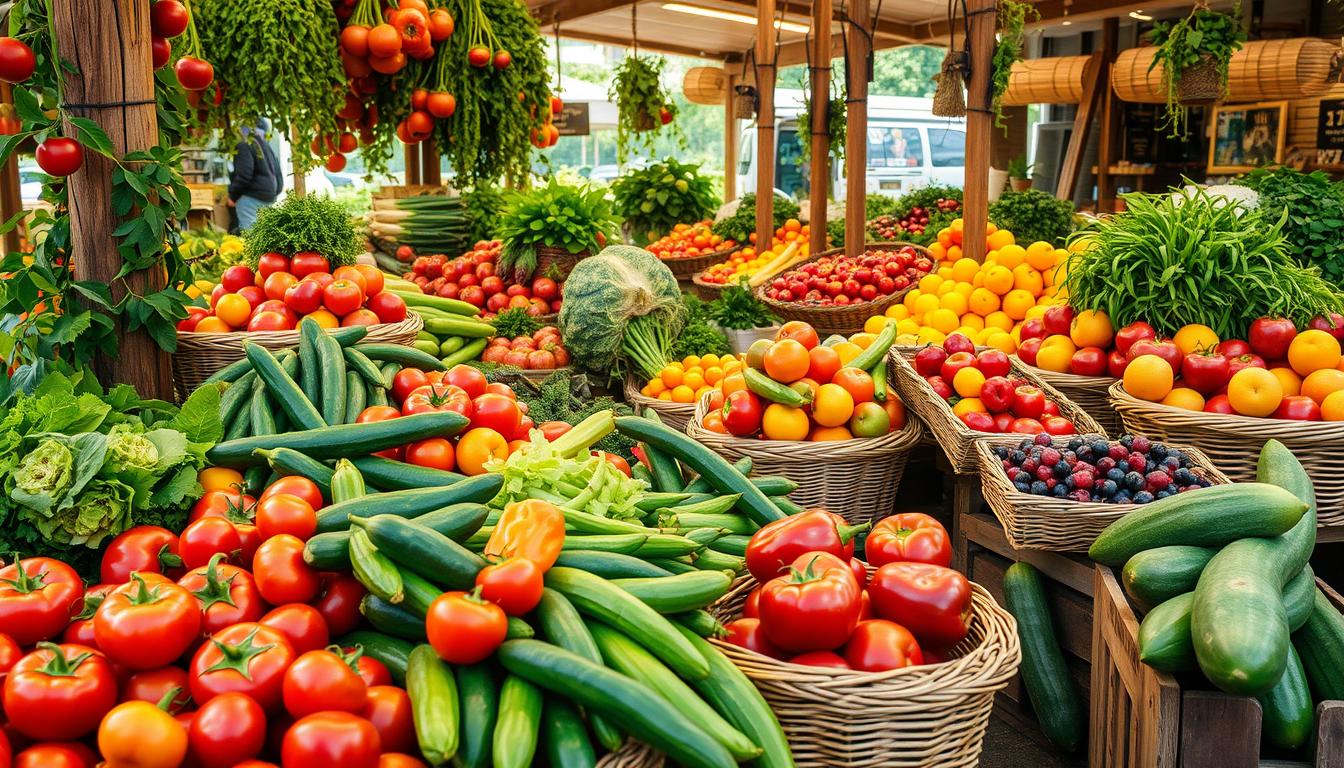Our food choices greatly affect our health and the planet. It’s time to learn about the benefits of non-GMO products. We’ll look into the science of genetic modification, GMO crops’ history, and their use today. You’ll gain the knowledge to make better food choices. What if the foods we eat could harm us without us knowing? We’ll dive into GMOs and why choosing non-GMO is key for our health and the planet. You’ll discover how to choose a more natural, sustainable food path. Key Takeaways Discover the science behind GMOs and their impact on food production. Explore the benefits of choosing non-GMO products in your diet. Learn how to identify and avoid GMO ingredients through effective food labeling. Discover natural alternatives to GMO products and support sustainable agriculture. Understand the connection between organic farming and non-GMO foods. Understanding GMOs and Their Impact on Food Production Genetic modification, or genetic engineering, changes the genetic makeup of living things, like food crops. Scientists can add traits like more yield, pest resistance, or better nutrition. But, this technology also raises questions about its effects on the environment and health. The Science Behind Genetic Modification Genetic engineering involves finding and adding specific genes to another organism’s DNA. This can be done with plants, animals, or microorganisms. The aim is to create new life forms with special traits. For farming, it’s used to make crops more resistant to pests, diseases, and harsh weather. Historical Development of GMO Crops The first GMO crop, a tomato, was approved in the U.S. in 1994. Since then, GMO use in farming has grown. Now, crops like corn, soybeans, and canola are mostly GMO. This has raised concerns about its environmental impact. Current GMO Statistics in Agriculture In 2019, about 190.4 million hectares of land worldwide were used for GMO crops. The U.S. leads in GMO crop production, with 71.5 million hectares in 2019. Brazil, Argentina, Canada, and India are also big GMO producers. The most modified crops are soybeans, corn, cotton, and canola. As GMO use in farming grows, understanding its science and effects is key. It’s important for sustainable agriculture and the environment. Benefits of Choosing No GMOs in Your Diet More people are choosing non-GMO foods as GMO awareness grows. This choice is good for health and the environment. It’s a step towards a better lifestyle. Non-GMO diets may be healthier. Some research links GMOs to health problems like allergies and chronic diseases. By avoiding GMOs, you might avoid these risks and eat better. Choosing non-GMO also supports organic farming. Organic farming avoids harmful chemicals. This choice helps the planet and our health. Non-GMO foods are often more natural. They are less processed and closer to their natural state. This means better taste and nutrition. Choosing non-GMO food is not just about personal health – it’s about supporting a food system that is better for the planet and future generations.” – Jane Doe, Organic Farming Expert More people want to know where their food comes from. Non-GMO choices are becoming more appealing. They help create a healthier, more sustainable food system. Potential Health Benefits of Non-GMO Environmental Advantages of Non-GMO Reduced risk of allergies and digestive issues Minimized exposure to potential long-term health concerns Promotion of a more natural, whole-food-based diet Alignment with organic farming practices Reduced use of synthetic pesticides and fertilizers Support for a more sustainable food production system How to Identify and Avoid GMO Products Understanding food labels can seem hard, but don’t worry! We’ll show you how to spot and steer clear of genetically modified (GMO) foods. You’ll learn to read labels well and use the Food Scan Genius app. This way, you can choose what you eat wisely. Reading Food Labels Effectively To avoid GMO foods, start by getting good at reading labels. Look for the non-GMO or organic seals. These mean the product doesn’t have genetically modified stuff. Also, watch out for GMO ingredients like corn, soy, canola, and sugar beets. Common GMO Ingredients to Watch For Corn and corn-derived ingredients Soy and soy-derived ingredients Canola oil Sugar beets Cottonseed oil Papaya Zucchini and yellow squash Using the Food Scan Genius App for GMO Detection For more confidence, try the Food Scan Genius app. It lets you scan barcodes and tells you if a product has GMOs. This app makes choosing non-GMO foods easy. The Food Scan Genius app has been a game-changer for my family. It takes the guesswork out of grocery shopping and ensures we’re avoiding GMO products with ease. Get to know food labels, know the GMO ingredients, and use the Food Scan Genius app. You’ll be on your way to a non-GMO life. Enjoy making smart choices and feeling sure about your food. Natural Alternatives to GMO Products Looking for a healthier lifestyle? Explore natural, non-GMO alternatives to common foods. You can change your pantry, enjoy tasty snacks, or try new drinks. Nature’s power is in every delicious option. Choosing non-GMO doesn’t mean giving up taste or convenience. There’s a wide range of non-non-GMO products. From organic farming to sustainable agriculture, they help nourish you and the planet. Pantry Staples: Rethinking the Essentials Replace processed and GMO foods with wholesome, non-GMO pantry staples. Try different non-GMO flours, grains, and legumes for tasty meals. Choose brands that focus on sustainable agriculture and organic farming for your daily needs. Snacks and Treats: Satisfying Cravings Naturally Enjoy non-GMO products without losing flavor. Find crunchy chips, savory dips, sweet treats, and baked goods without GMOs. Look for brands that use high-quality, non-GMO ingredients for guilt-free indulgence. Beverages: Quenching Thirst the Natural Way Stay hydrated with non-GMO drinks. Avoid sugary, artificial drinks and choose refreshing non-GMO juices, teas, and non-dairy milks. These options not only quench your thirst but also offer nutrients and health benefits without GMOs. Product Category Non-GMO Alternatives Key Benefits Pantry Staples Non-GMO flours, grains, legumes Whole, unmodified ingredients; support for sustainable agriculture and organic farming Snacks and Treats Non-GMO chips, dips, baked goods Satisfy cravings with natural,
No Sulfites: Natural Wine Selection for Health Conscious
We’re excited to share the world of natural wines with no added sulfites with you. These wines are pure and organic, perfect for health-conscious wine lovers. They let you enjoy your favorite drink without harmful additives. Let’s dive into the benefits and tastes of these special wines. Key Takeaways Discover the world of natural wines with no added sulfites Learn about the benefits of choosing sulfite-free wines for your health Explore the different winemaking methods that produce these pure, organic wines Understand the rise of organic and biodynamic wine production Discover top regions and producers of natural, sulfite-free wines Understanding Natural Wine: A Pure Approach to Winemaking A new movement in winemaking focuses on natural and sustainable methods. Sulfite-free wines are made with little intervention and organic practices. They are winning over wine lovers. Let’s explore the traditional methods and the philosophy behind this approach. Traditional vs. Modern Winemaking Methods Modern winemaking often uses additives and technology. But natural winemakers stick to traditional techniques. They let grapes show their true flavors and terroir. This careful process includes: Organic and biodynamic farming to care for the vines Little or no sulfites, unlike many conventional wines Spontaneous fermentation with natural yeast Gentle pressing and aging in neutral oak The Philosophy Behind Natural Wine Production Natural wine production is more than just winemaking. It’s a sustainable lifestyle for these winemakers. They aim to make preservative-free wines that show the land’s unique character. They respect the grape’s authenticity and nature’s rhythms, while reducing environmental harm. Natural winemakers want to share the true taste of the terroir. They avoid the heavy influence of modern winemaking. Their dedication to sulfite-free wines shows their love for winemaking and the environment. “We’re not just making wine, we’re telling a story – the story of the land, the people, and the gentle touch that brings it all together.” – Jane Doe, Natural Winemaker What Makes Wine Truly Sulfite-Free? Finding no sulfites wines means knowing how they’re made. Natural wines use methods without additives. This makes them different from regular wines. No sulfites wines don’t have added sulfites. Sulfites help keep wine fresh longer. But, no sulfites wines offer a natural choice for those who want it. Organic and biodynamic farming practices: Natural wine makers use sustainable farming. This means no synthetic additives like sulfites. Minimal intervention in the winemaking process: No sulfites wines are made with care. They avoid heavy processing to let the grape’s natural flavors show. Careful fermentation and aging: The making and aging of additive-free wines are done with great attention. This keeps the wine pure, without sulfites. The beauty of no sulfites wines lies in their ability to let the true essence of the grape shine through, offering a pure and authentic drinking experience.” Learning about the winemaking for sulfite-free wines opens up a new world. You can find natural, additive-free wines that are good for your health. Health Benefits of Choosing No Sulfites Wines Wine lovers looking for a healthier choice are finding it in organic wine and preservative-free options. These wines, without sulfites, bring many health benefits to the table. Reduced Allergic Reactions and Sensitivities Sulfites in regular wines can cause allergies and sensitivities. Choosing no-sulfites-added wines might help reduce these issues. Symptoms like headaches and breathing problems could lessen. Better Digestibility and Fewer Headaches Without added sulfites, natural wines are easier to digest and may cause fewer headaches. Sulfites can upset your stomach. Not using them makes wine more enjoyable and less likely to cause problems. Natural Antioxidant Properties Organic wine makers often stick to old-school methods. This keeps the grapes’ natural antioxidants. These antioxidants are good for your health and might help fight off age-related diseases. By picking preservative-free wines, you start a new adventure. You’ll learn about the health benefits of these natural wines. The no-sulfites movement is changing how we see and enjoy wine. The Rise of Organic and Biodynamic Wine Production Winemaking is changing, moving towards more sustainable methods. Organic and biodynamic wine production are becoming more popular. People want wines that taste great and are good for the planet. Organic and biodynamic winemaking focus on natural methods. They avoid synthetic fertilizers and pesticides. Instead, they use natural ways to grow grapes and make wine. Organic wine growers use natural compost and cover crops. They manage the soil carefully. This makes grapes full of flavor and helps the environment. Biodynamic winemaking sees the vineyard as a living thing. Growers use natural preparations and farming rhythms. This approach makes the soil and vines healthy, creating amazing organic wines without additives. Organic Wine Biodynamic Wine Grown without synthetic pesticides or fertilizers Follows biodynamic principles, treating the vineyard as a self-sustaining ecosystem Grapes are certified organic Utilizes natural preparations and rhythmic farming techniques May contain low levels of sulfites Sulfite-free The demand for sustainable wines is rising. Organic and biodynamic wines offer a healthy choice. They are delicious and support the environment. The future of winemaking lies in the hands of those who embrace the principles of organic and biodynamic farming. These sustainable practices not only produce exceptional wines but also contribute to the preservation of our planet. Top Regions Producing Natural Sulfite-Free Wines The natural wine movement is growing fast. We’re excited to look at the top places known for making great sulfite-free, organic wines. From Europe’s old vineyards to the new producers in the New World, and the new markets starting to make natural wines, let’s explore the wide world of natural wine. European Natural Wine Regions Europe is at the heart of traditional winemaking. Places like France’s Loire Valley, Italy’s Piedmont, and Spain’s Catalonia are full of winemakers who love to make natural wine without sulfites. They work hard in their vineyards, using methods like biodynamic and organic farming. This way, they make sulfite-free wines that really show off the land’s flavor. New World Natural Wine Destinations The New World is also making a big impact in natural wine. Places like California’s Sonoma County, Chile’s Casablanca Valley,






